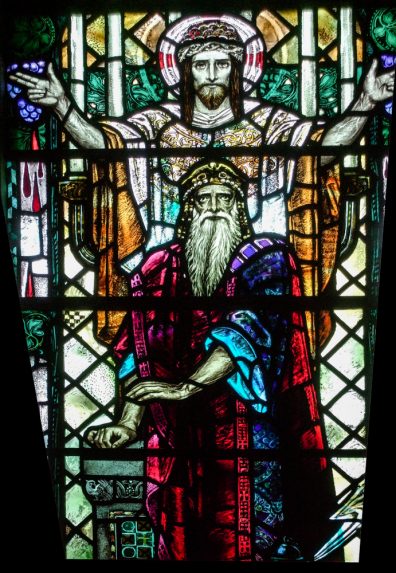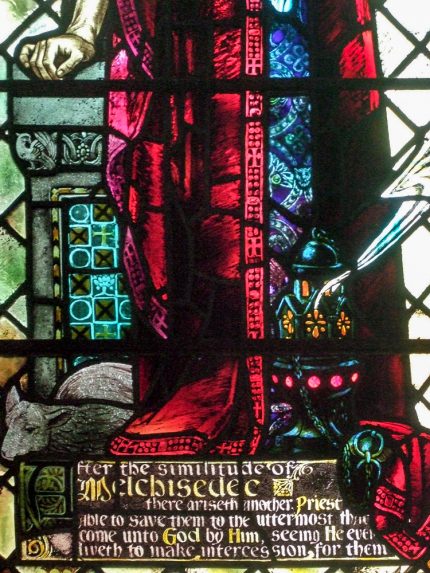2 - Westruther Parish Church, Scottish Borders
Address
Westruther Parish Church, Westruther, TD3 6NETheme
Overview
This entry is part 2 of a 10 part essay by Douglas Hogg with the title “The Lion in the North – a 20th century lineage – A personally immersive account of the development and influence of a progression in the use of glass painting in Scotland as an expressive form, with particular reference to this as a unique and identifiable east coast phenomenon.” The full essay can be read in the themes section, where there are also links to each of the locations that are discussed.
Highlight
East end south wall window (Webster) and east window (Strachan)Artist, maker and date
Alfred Webster, c.1910 & Douglas Strachan, c.1902Reason for highlighting
It is at Westruther Parish Church in the Scottish Borders where we again see examples of the two artists previously mentioned with both of them being from an earlier period in each artist’s career. The more artistically significant is the Alf Webster window dating from c.1910. Here, the whole image is imbued with an Irish / Celtic ambient glow of an almost mythological light and atmosphere. My attention is drawn to a possible connection between Scottish west coast artworks and Irish artworks developing simultaneously during the period.
In this window Webster’s composition appears as being compositionally ‘stacked’ with the figure above re-enforcing a vertical intent. Some may say that the inevitable verticality of a window space may deem this as normal in any case, but nevertheless this particular configuration can appear as a descending motion towards us and as such a bit unusual. It is certainly quite striking and might reasonably contain echoes of a ground-breaking artwork which had just appeared in Glasgow around that time. At any rate Webster would be aware of a new painting: “The Druids: Bringing in the Mistletoe” (1890) by George Henry and E A Hornel, two of the influential group of painters called the Glasgow Boys. They both worked on this painting together which can be seen at the Kelvingrove Art Gallery and Museum in Glasgow. The painting shows a group of figures in vertical procession descending towards the viewer and gathered fame, being considered as quite a novel form of composition, noted also for its distinctive mood and atmosphere. The painting has decorative elements added to it as a surface embellishment with gold leaf being used in parts. An early awakening perhaps of a developing European focus on surface qualities of design and texture.
Bearing such possible confluency in mind, I can detect in the window instances which might have been the forerunner of a decorative style engaged by the Irish artist Harry Clarke. The Kelvingrove Gallery has recently added a Harry Clarke window to its collection which I feel looks a bit sad and lonesome, lacking in good company perhaps, its graphic mannerism and colourful flamboyance under-exploited. The possible tripartite connection has not been formally advanced and remains merely a personal notion.
The figured window, a very early Douglas Strachan here dates from his Aberdeen origins when he worked for the commercial glazing firm of James Garvie and Sons. Here we see heavy commercial leaded glass work with figures, the brown suppressive modelling of which would carry on in the work of his brother Alex. Douglas had travelled south taking up work as a black and white graphic artist and a cartoonist on a Manchester newspaper where we can probably trace his great tonal strength and compositional power. He was invited to set up a new course in Design and Craft subjects at the Edinburgh College of Art (ECA). Leaving his brother in charge of the stained glass course Douglas left, committing his attention to completing a set of four windows for the Peace Palace at the Hague (1911) and thereafter on to a celebrated career as Scotland’s most notable stained glass artist of the 20th century.
The other window in the church dates around the late 1960’s or early 1970’s. The artist remains unknown but this is a window which comes from the stable of ECA.
Other comments
The fate of this building is currently in the hands of the Trustees of the Church of Scotland as the congregation voted to close it down when their minister recently retired. It might be hoped that the Webster window can be saved. But given recent experience where an exquisite canopy set of the Creation by Strachan in a church nearby was lost to the bulldozer, I can’t hold out that much hope. This, in spite of having approached the two nominal stained glass repositories north and south of the border as well as national heritage bodies advising them of this impending loss.
This is the second part of a 10 part essay, to continue reading please follow the link below
Part 3 – Sprouston Parish Church, Kelso, Scottish Borders
Alternatively the whole essay, without pictures, can be read as a PDF here, or to go to the beginning of the essay click Part 1 – St Andrew’s and St George’s West Church, Edinburgh.
Artist/maker notes
Alfred Alexander (Alf) Webster (1883-1915) enrolled at the Glasgow School of Art in 1903 and the following year joined the studio of Stephen Adam, becoming a partner in 1909 and taking over the studio the following year after Adam’s death. After joining Adam he rapidly proved himself to be an artist of extraordinary talent capable, who, as Donnelly notes, “was producing glass which, for technical control of colour, texture and transparency, alone among his contemporaries, can bear comparison with that other genius of stained glass, the Irish artist Harry Clarke”.
Tragically he was killed in Flanders in August 1915, aged just 31, having taken a commission as a 2nd Lieutenant in the Gordon Highlanders.
Source: Scotland’s Stained Glass Making the colours sing by Michael Donnelly (Historic Scotland, 1977)
Robert Douglas Strachan (1875-1950) was born in Aberdeen and initially trained as an artist. Indeed Strachan admitted later in life that he had been slow to realise that stained glass would be the best outlet for his artistic vision. It was a vision that enable him to become the foremost British stained glass artists of the generation after Christopher Whall. From 1909 to 1911 he was head of the School of Design and Crafts at the Edinburgh College of Art, before handing over to his brother, Alexander, due to pressure of work. His windows are found throughout Scotland and England, and are recognisable for their bold use of colour, and strong sculptural design and use of lead. Overseas he is renowned for his windows at the Peace Palace in The Hague, The Netherlands.
Sources:
In Praise of Douglas Strachan by Peter Cormack, Journal of Stained Glass, Vol. XXX, 2006
Arts & Crafts Stained Glass by Peter Cormack (Yale University Press for The Paul Mellon Centre for Studies in British Art, 2015)
ECA Glass Alumni Exhibition Catalogue, pages 11-12
An immersive and reflective account of the life and work of Douglas Strachan can be found online in a PhD thesis by Professor Juliette Macdonald for St Andrew’s University. Professor Macdonald is currently Head of the School of Design / Personal Chair of Craft History and Theory at ECA. Aspect of identity in the work of Douglas Strachan (185-1950) – St Andrews Research Repository



Comments by
Douglas Hogg